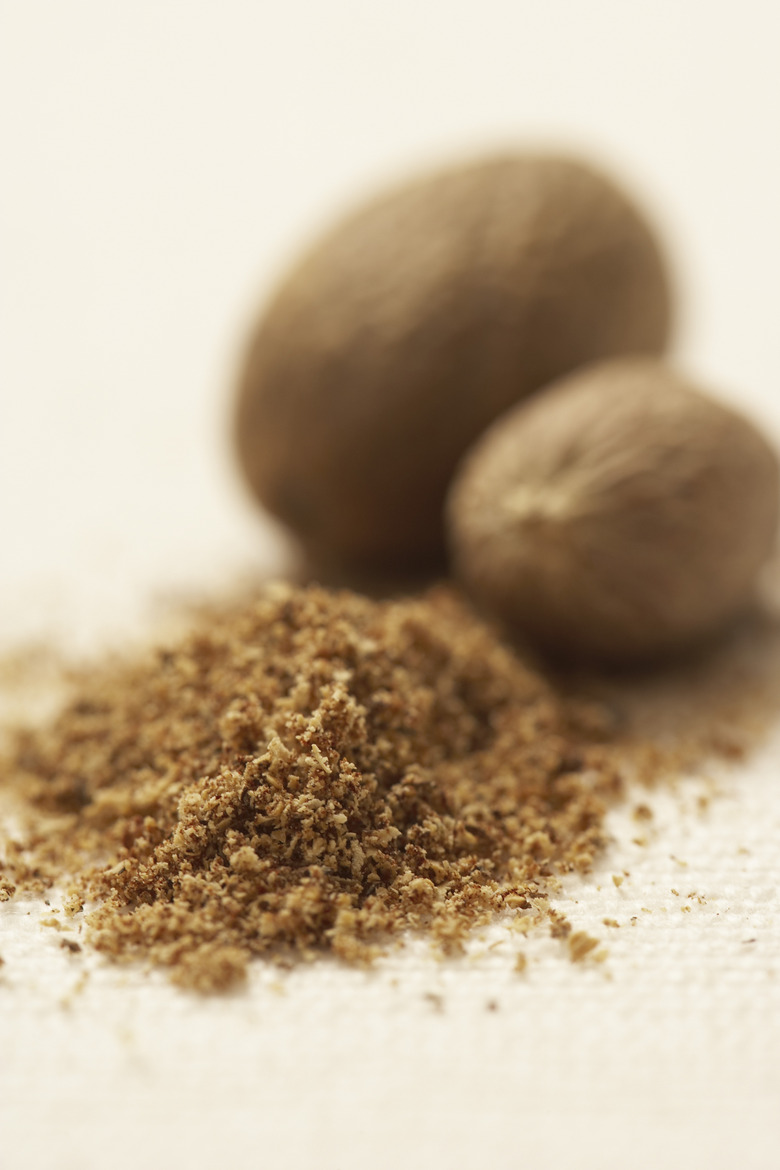In What Type Of Climate Is Nutmeg Grown?
An exotic spice with a warm, sweet perfume and earthy flavor, nutmeg is a familiar ingredients in cookies, cakes and eggnog. Nutmeg's sensuous aroma was so valued by rich Europeans in the 17th and 18th centuries that countries vied for control of the so-called Spice Islands in the East Indies. The Dutch, who ruled over the islands, massacred native planters and destroyed farms in a campaign to dominate the spice trade and foil the British. Today, nutmeg is cultivated on commercial farms in tropical regions and is readily available in grocery stores worldwide.
Nutmeg
Nutmeg
Nutmeg is the seed of the Myristica fragrans tree, an evergreen that is native to the Moluccas, or Spice Islands, in modern Indonesia. When fresh, the nutmeg fruit is pear-shaped and light cream or yellow. The central seed of the fruit is small, dark brown, round or oval, and encased in a red, lacy covering called an aril. The seed and aril are separated and dried. The brown seed is sold whole or ground as nutmeg, and the aril is ground and sold as mace.
Climate and Soil
Climate and Soil
Nutmeg thrives in a tropical climate with humid conditions the year around and a temperature range of 77 to 95 degrees Fahrenheit. The plants grow best in climates with at least 60 inches of annual rainfall and at elevations up to 4,265 feet. While the Myristica species love a drenching rain, the soil in which the trees are planted must drain well — the shallow roots won't tolerate chronically soggy conditions. For this reason, nutmeg trees are usually grown on mountain slopes. Clay loam, sandy loam and red laterite soils are ideal.
Regions
Regions
Nutmeg's original habitat was restricted to the Banda Islands, a tiny volcanic archipelago within the Moluccas, between the larger Indonesian islands of Sulawesi and Papua. Today, the once-rare spice is commercially cultivated in Indonesia, which produces more than 50 percent of the world's exported nutmeg. Grenada is the second-largest producer, followed by India and Sri Lanka. Nutmeg can adapt well to any region as long as there is well-drained volcanic soil, abundant precipitation and consistently warm temperatures.
Threats
Threats
Nutmeg groves are susceptible to damage from weather, disease and insects. High winds and typhoons, which are common in the tropics, can destroy the plants. Too much sun can scorch young seedlings' leaves, so many farmers intersperse shade trees with nutmeg trees on their farms. Nutmeg plants can also suffer from fruit rot, thread blight and other fungal infections. Black, white and shield scale insect can cause the leaves of young plants to wilt.
Cite This Article
MLA
Long, Kat. "In What Type Of Climate Is Nutmeg Grown?" sciencing.com, https://www.sciencing.com/type-climate-nutmeg-grown-5144/. 24 April 2017.
APA
Long, Kat. (2017, April 24). In What Type Of Climate Is Nutmeg Grown?. sciencing.com. Retrieved from https://www.sciencing.com/type-climate-nutmeg-grown-5144/
Chicago
Long, Kat. In What Type Of Climate Is Nutmeg Grown? last modified March 24, 2022. https://www.sciencing.com/type-climate-nutmeg-grown-5144/
